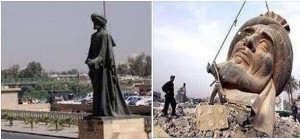 News from Iraq has revealed that Militant Islamists, with strict Salafi interpretations of Islam deeming the veneration of tombs to be idolatrous, have destroyed the statue of the Poet Abu Tammam in addition to the statues of Othman al-Mousuli, a 19th Century Iraqi musician and composer and Ibn al-Athir’s, an Arab philosopher.
News from Iraq has revealed that Militant Islamists, with strict Salafi interpretations of Islam deeming the veneration of tombs to be idolatrous, have destroyed the statue of the Poet Abu Tammam in addition to the statues of Othman al-Mousuli, a 19th Century Iraqi musician and composer and Ibn al-Athir’s, an Arab philosopher.
Why would anybody attack,deface,or destroy a statue of a poet (who is not technically worshiped)?
The conventional knowledge about Abu Tammam’s poetry and life does not give an easy answer in this regard. Abu Tammam (805 – 845 AD) is an Abbasid-era Arab poet and editor of an anthology of early Arabic poems known as the Hamasah. Al-Hamasa (Heroism), consists of hundreds of poems from pre-Mohammed Arabia down to his own time, mostly by less famous poets. Unlike his own poetry, the works he collected and thus helped preserve have been universally celebrated as among the purist models of classic Arabic form. 1
He is famously known for his poem “Ode on the Conquest of Amorium”; a classical Arabic panegyric ode set in 838, composed in Arabic (as “Al-sayfu asdaqu anba’an min al-kutubi”) in 838. The poem celebrates the Sack of Amorium by the Abbasid Caliphate in mid-August 838, which was one of the major events in the long history of the Arab–Byzantine Wars.
According to Encyclopedia Britannica,
Abu Tammam was born to a Christian father, but converted to Islam. He worked in his youth in Damascus as a weaver’s assistant but on going to Egypt began to study poetry. It is not certain when he began to write verse, but by the time of the caliph al-Muʿtaṣim (reigned 833–842) he had established a small reputation. This was greatly enlarged through his association with al-Muʿtaṣim’s court, where he became the most acclaimed panegyrist of his day. He traveled to Armenia and Nīshāpūr, Iran, and on his return from Iran stopped in Hamadan, where he began compiling his Ḥamāsah.
Having said that, readers might not be aware that Abu Tammam is one of the most controversial figures in Arab poetics. There are many modernistic features about Abu Tammam that are not generally included in the conventional narrative of Classical Arabic Poetry, including:
- His intellectual pursuits
- His modern poetics
- His philosophical thought
His Intellectual Pursuits
Early Muslim critics regarded Pre-Islamic poetry as the perfect template:
Innovation being condemned from the outset, the poets who most wanted the approval of this self- proclaimed Academy – of grammarians – were obliged to spend their time and talents in producing complex imitations of the ancient masterpieces, mainly al-Mu’allaqat: The Suspended Odes, and to amuse courtiers with borrowed images of Bedouin life in which neither they, nor their audience, had the slightest interest.
Urbanization and changes in the socio-political climate during the seventh and eighth centuries led pioneering poets such as Bashar ibn Burd (714-784) and Abu Nuwas (756–814) to transpose the language, images, and metaphors from their current lives into their poems. In a similar vain, Abu Tammam took the pioneering mission to anthologize and propose new paradigms in writing that were faithful to the dynamics of those times.
Abu Tammam promoted the use of innovative (mudath) style of poetry as opposed to traditional poetry represented by Al Buhturi‘s work. He also embedded philosophical questions and developed new rhetoric in his new “urban poem”, which acquired considerable attention at his time giving him the opportunity to “monopolize the poetry market” . Al-Asfahani reported that
None of the poets was able to make a dirham when Abu Tammam was alive, and that when he died, they divided what he would have received among themselves.2
His Modern Poetics
Abu Tammam’s verse belongs to the new type of poetry that was written by Bashar ibn Burd and Abu Nuwas, who derived their diction and imagery from contemporary life.
His poems contain, side by side with brilliant conceits which have established the poet’s fame, much that is unpleasant and strange. He had a desire not only for odd words but also for artificial, frequently tortuous sentence structure that frustrated the most capable of Arabic commentators. In addition, his poetry abounds with symbolism and strange personifications of abstract ideas and oftentimes a barrage of far fetched and unconvincing metaphors that annoy the reader for many verses at a stretch until he finally stumbles on an excellent poetical metaphor.
He wrote urban love and social justice:
To scorn me thus because I’m poor!
Canst thou a liberal hand upbraid
For dealing round some worthless ore ?
To spare’s the wish of little souls,
The great but gather to bestow;
Yon current down the mountain rolls,
And stagnates in the swamp below.
According to Schppers (1), Abu Tammam challenged traditional writing through the use of genitive metaphors. For example:
Flashes of lightnings are called “banners of the dark rainclouds”, and the morning mist “the musk of the dew”, and in the description of wine he mentions the hands which carry the cups of wine as “pack-animals of the wine” and the cups become “pack-animals of desire in the intestines”.
And because of his new outlook on modernizing language and the thought process behind language, Abu Tammam’s poetry was attacked by Imams and Sheikhs during his life and hundreds of years later. In his description of Abu Tammam’s poetic style, Al-Amidi wrote:
I heard very often the Sheikhs saying that this verse (Abu Tammam’s) is ravings and delirium, because poetry is only good, if it is understandable and these things that he says here are closed, hermetic, not according to the school of the former poets. 2
Ibn Al-Athir – who came decades after Abu Tammam and whose statue was defaced as well – defended Abu Tammam’s poetics which influenced AL-Mutanabi and Al Maari:
As wine brings the intellect into another condition, so the verbs bring the words into another condition. 3
His philosophical thought
Abu Tammam used his poems to convey his philosophical thoughts, therefore his poem demanded educated readership. Once Abu Tammam was asked: “Why don’t you write verses that can be understood”? He answered: “Why can’t you understand what the verses say”.
Abu Tammam was a philanderer, at best, a libertine. His neglect of the performance of religious duties frequently arouse suspicions about his true believes.
Recently, Adunis described Abu Tammam as “the Mallarme of the Arabs”, citing his originality and his deviation from previous models. He noted that:
Abu Tammam started out from a vision of poetry as a sort of creation of the world through language, comparing the relationship between the poet and the word to the relationship between two lovers, and the act of composing poetry to the sexual act. 4
Robert Fisk discusses that exact act of composing poetry in the context of statues destroyed in Syria by the end of 2013:
… Or was it because Abu Tammam brazenly compared the composition of poetry to the sex act? May he be turned to dust!
In his book “An Introduction to Arab Poetics”, Adunis included Abu Tammam in the bunch of other revolutionary poets: Al Maari and Al Mutanabbi as a “living force which moves the world” and “creates new modes of poetry and thought”. Therefore, it does not come as a surprise that recent defacement and destruction of the statue of Abu Tammam and others carry a symbolic message trickling from an ancient heritage of conservative thought against modernity, freedom of speech, and freedom of vision.


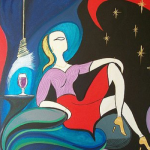

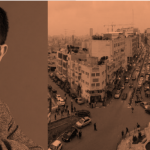
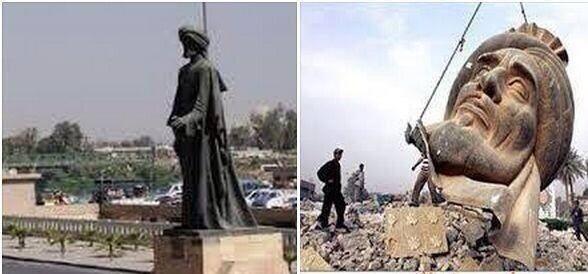
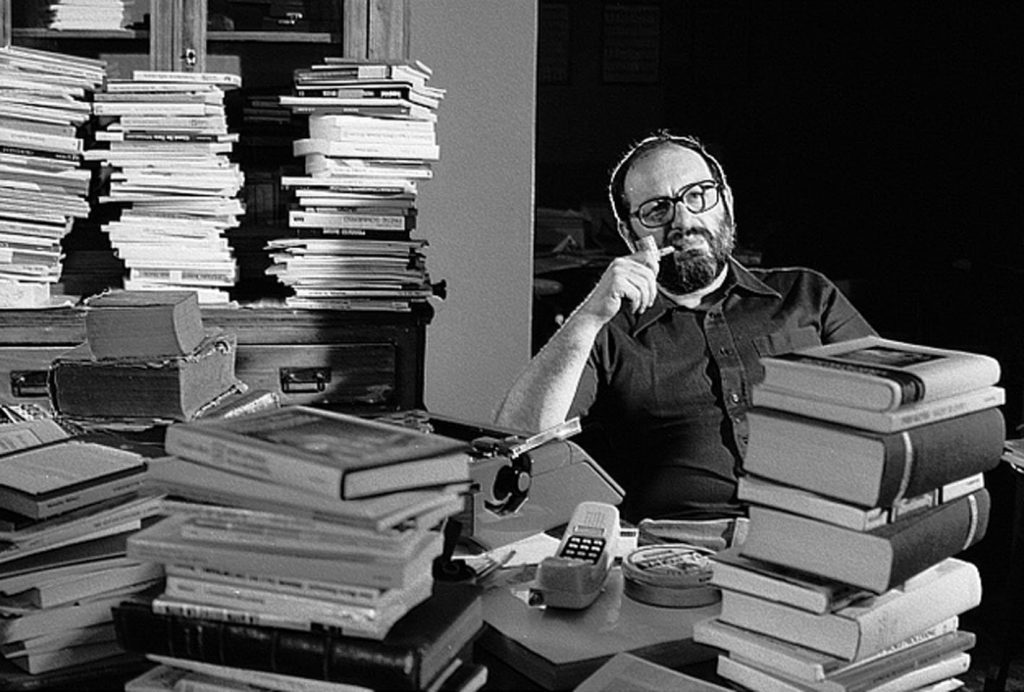
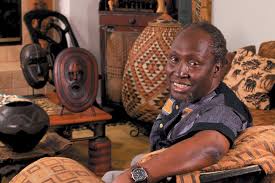


A Moment in Ramallah / John Berger
Orientalism is a cultural and a political fact / Edward Said
Befriending Edward Said